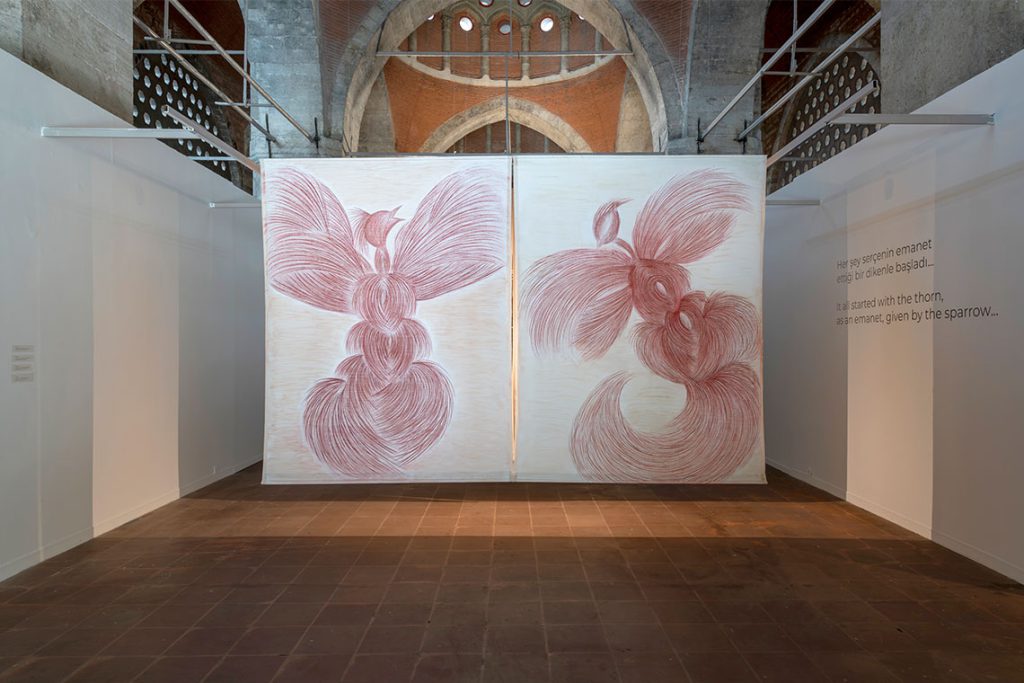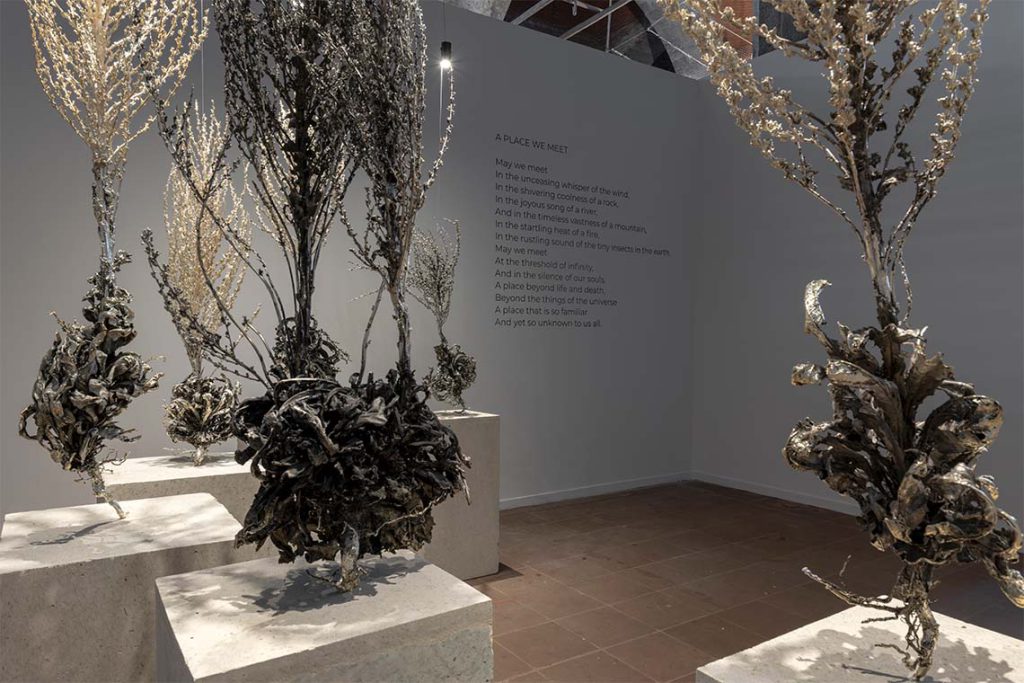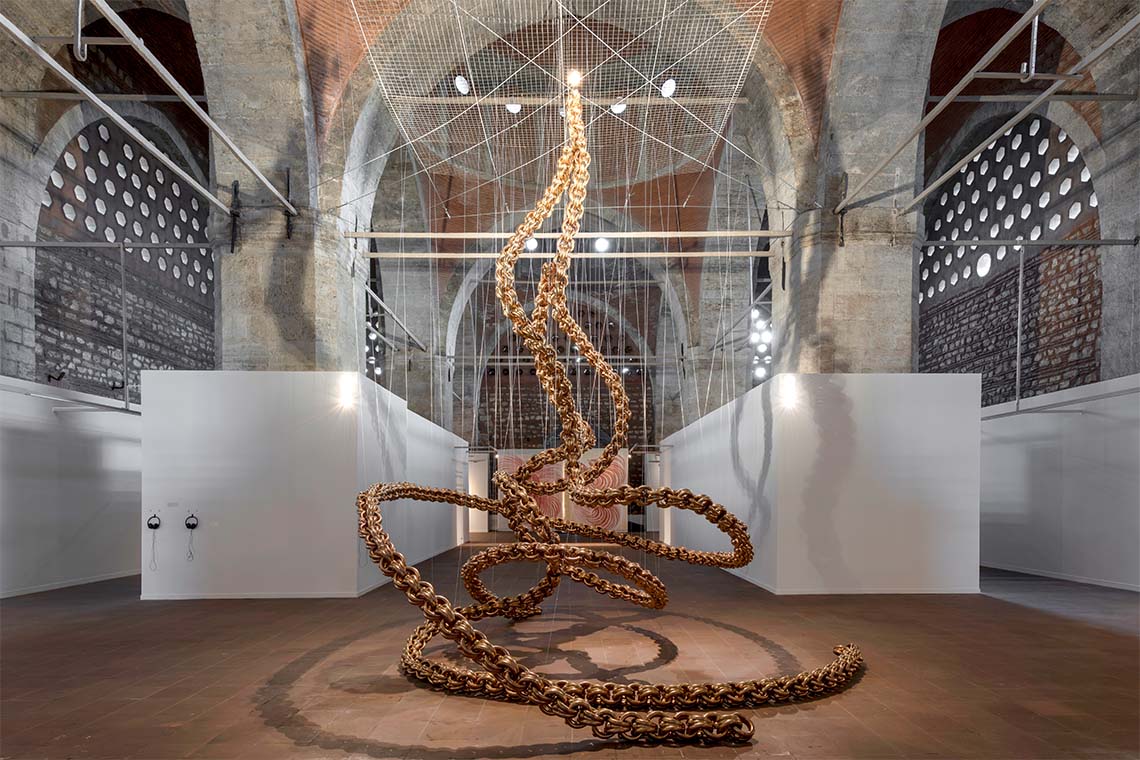Quiet and introspective, Vuslat’s solo show, Emanet, looks to values of trust and guardianship, unfolding as a memory sequence contemplating ancient roots and collective traditions.
Encircled by poetic incantations, whirling clay entities and fragments of forgiveness, a rope of gilded chain links cascades from the central dome of the Tophane-i Amire Cultural and Art Center in Istanbul. Once an artillery factory and armoury for the Ottoman army, the structure currently hosts Emanet, the second iteration of the travelling solo exhibition of Turkish activist and artist, Vuslat.
A profound contemplation on ancient roots and collective traditions, interlaced with Vuslat’s philosophy of remembering, healing and preserving, the show unfolds as a polyphonic memory recording. Across various perspectives, sculptures, paintings and sound installations the works weave a sensorial narrative landscape that opens itself to “cinematographic thinking”, as put by Ebru Yetişkin, the exhibition’s curator.
Amid the stone-and-brick vaults, an almost palpable sensation of vitality emanates from the monumental centrepiece, the Umbilical Cord of Life (2023).The work is a spinal manifestation of Emanet – the exhibition’s grounding ethos that refers to the practice of entrusting a precious object to someone, often a keepsake, to preserve for generations to come.
The interlocking chain installation is a remodelling of a necklace given to Vuslat by her grandmother into an artifact that speaks to the cycle of life and death, perhaps the most crucial emanet of all. In its form, the work resembles a DNA chain – its materiality is a carrier of moments, stories and identities while symbolic of the relationships we form with one another and ourselves.

Each work serves as a crystallisation of thought, guiding the observer on a journey of many momentums, traversing the spiritual, philosophical and cosmological. Following a series of charcoal drawings, an exercise of Vuslat rediscovering her ancestral roots, the heart of the exhibition is concealed behind a set of vast hanging sparrow figures. Bold brushstrokes formed with natural pigments made from stones and soil collected from the region reveal the image of a feathered sparrow – the protagonist of a folktale that Vuslat fondly recalls hearing from her grandmother throughout her childhood. Ahead, this is reconstructed in an immersive memory recording with Story of the Little Sparrow (2024).
Resonating with various historical and contemporary cultures and geographies, the idea of emanet deeply embodies values of trust, fidelity, care and guardianship. To the artist, these values form the basis of a mutual contract. In the context of transient yet interdependent contemporary global conditions, both socially and environmentally, Vuslat maintains that this enables humanity to foster stronger connections with one another, as well as with the world that we inhabit.
Nature is therefore a crucial and all-encompassing emanet, likened by the artist and curator to the notion of coexistence, wherein humanity is entrusted to protect Earth, which in turn takes care of us. This concept emerged when Vuslat was invited to Bayburt for Emanet’s inaugural show, which yet materialises across her organic approach to form and materiality, encompassing natural pigments, mineral-coated foliage, clay renderings, textiles and sound, together weaving images of natural landscapes.

A Place We Meet II (2023) is a poetic, sculptural installation in which mullein plants cast in silver rest on Bayburt stone plinths. The species has thrived across the region’s mountainous terrain for at least 2000 years, long ago valued by villagers for its healing properties and used to make medicine, and now serving as mere scraps to fuel a fire. A forgotten memory. While the Umbilical Cord of Life intertwines moments of present and past, this series reflects on the possibility of regeneration and the afterlife with a sense of optimism and despair. Its fallen leaves are further set into clay for the Amulet Series (2023), configuring the power of ritualistic action in an explosive composition, reflecting the harsh realities of our inner darkness.
Beyond, two large canvases gently suspend from the ceiling like the pages of a book, embroidered with the semantic roots of the word emanet, deriving from “E-M-N”. Titled Embrace (2024), the work is a collaboration with artist Pelda Aytas and women villagers who have for centuries passed down the wisdom and craftwork of the kilim, documenting in natural-dyed yarn the word’s equivalents in nine different languages. Conveying the shared cultural geography we inhabit, and the individuality of each, the hues of the threads represent the word’s values in Aramaic-Syriac, Hebrew, Arabic, Persian, Urdu, Turkish, Greek, and Kurdish.
At the intersection of language, culture, and art, Emanet raises questions about how we instil value in the objects, places and people around us. Vuslat unifies diverse heritages to create a narrative that seeks to strengthen the connections we forge, centred around an ideal of optimism, yet without overlooking moments of inner turmoil. Extending from one memory sequence to the next, the works thus root different perspectives on ancestral traditions, rituals and wisdom, to curate a holistic understanding of the past and present, and to open up new possibilities for imagining life.



